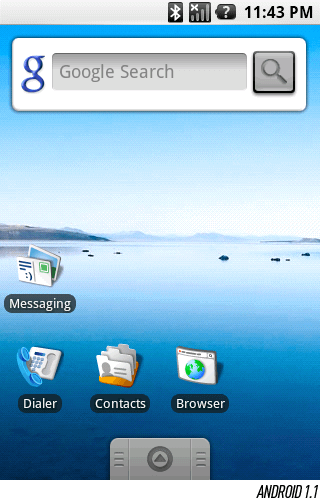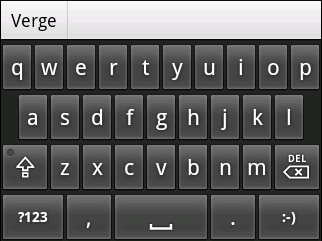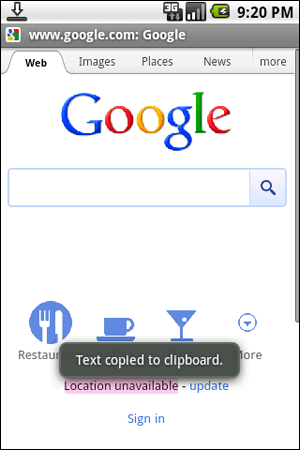
Update Android 1.1 for T-Mobile G1 was launched in February 2009. He can be said not only that this firmware eliminates many of the defects inherent in the first version. Its major advantage is the ability to receive updates “over the air”. Today it sounds mundane, but then this was a great opportunity to progress. But the main theme of this story would not she, but Android 1.5 , better known by his code name Cupcake . So the English-speaking foodies called cupcakes. Today Android , along with the known in history iOS , dominates the market for operating systems for mobile devices.
I must say that it is this version of the Google laid a tradition to give their mobile operating systems ‘confectionery’ names in alphabetical order. This list excludes some of the letters as «X», which do not begin with the names of popular sweets. But in general, this principle is the name preserved and now.

Cupcake brought a certain luster to the original “android” interface. Some changes are almost invisible if you do not know about them. A good example is the standard search widget Google, located on the home screen of many devices. He gained transparency and was slightly decorated. Members of operating systems 1.1 and 1.5 may not even notice any difference. All of the text alignment to the shading status bar looks the same. Most users of G1 does not even pay attention to changes in the operating system interface. But you can not say that Android 1.5 was only a minor update.

screen keyboard. Today, for many surprising is the fact that the first Android was generally devoid of even a hint of the onscreen keyboard. The fact that the T-Mobile G1 is horizontal slider with a physical QWERTY-keyboard. In April 2009, the Android 1.5 platform was the HTC Magic, the first phone based on the mobile operating system from Google, is located only a touch interface.
Along with the introduction of its mobile OS virtual keyboard, Google has made a significant step forward: the search engine company to give developers the ability to create your keyboard, replacing the standard. This feature of the present day differs from its Android rivals. Neither iOS, or Windows Phone does not offer such opportunities to third-party creators of applications. Introduced in Android 1.5 on-screen keyboard, according to many critics, gave way to the same element for the iOS platform for speed and accuracy. This has prompted manufacturers such phones like HTC, rapidly develop their keyboard to its proprietary “android” devices. This was the first example of rework Android makers of electronics.
advanced widget system capabilities. Widgets were present in Android 1.0, and 1.1, but its potential could not be fully revealed because Google has given developers SDK. Therefore, users have been available just a few widgets. Starting with version 1.5, many (if not most) of third-party application developers offer users one or more widgets. For Android this quality has an important value. Widgets make flexible platform compared to other mobile operating systems, and its home screen more customizable to the needs of each user.

Enhanced clipboard. Copy and paste on Android has undergone a difficult way to improve. Initially, they were present, but their range of application was limited text fields and links. This meant that from the browser window, or copy the text of Gmail was impossible. But that’s where the user is most often need to copy the text fragment. Before the clipboard was compatible with Gmail, Google’s required to release several versions of its mobile platform. In Cupcake has added support for the browser with the ability to copy text from the usual plain his window.
Video capture and playback recorded. It is hard to imagine a smartphone that does not know how to shoot video. But users T-Mobile G1 with smartphone were intimately familiar. With the arrival of Cupcake, this problem was solved in theory. In practice, the built-in camera interface has become the most criticized part of Android 1.5. This interface was soon replaced by the device manufacturers. Their version was more interesting and contain additional scenes, modes and options, as well as comfort solutions, such as touch focus.
Much more. Before version 1.5 the user has not been able to remove or archive of messages. It is in the Cupcake was implemented support for YouTube and Picasa. The same system has a universal (the Platform) access to the status of contacts Google Talk: from the window contacts, applications, Messaging and Mail Gmail. Synchronize extended information about the contact between applications and screens became the directions that follow Android and beyond.
Android 1.6 Donut deserved better than the addition of one-tenth in the version number. Exterior changes were minimal. Most of the improvements have touched the software side, the user does not see, but it feels great when it comes to the resolution of the screen, or it needs a network.
This “donut” platform has continued the tradition of “sweet” names of the mobile OS from Google. She brought with her support for networks CDMA, opening the way for “android” smartphone to hundreds of millions of Asian customers, as well as customers in the U.S. operator Verizon.
Donut for the first time provided support for the Android platform a variety of scans and screen resolutions. This was the starting point for the emergence of phone, screen resolution, which differed from the original 320 x 480, fixed in portrait (vertical) scan. If you look at the large family of modern “android” phones, there exist devices with resolutions QVGA, HVGA, WVGA, FWVGA, qHD and 720p. Perhaps if you search well, you can find and a couple of phones with portrait QWERTY-keyboard. All this variety is made possible by the foundations laid version 1.6.

sources of the idea of ??universal search unit Quick Search Box as are found in Donut. Previously, clicking on the “android” search button, the user simply hitting the Google page and get the opportunity to enter a search query there. Version 1.6 has allowed not only to search for content on the Internet, but also on the device itself. It has become possible to search for applications, contacts, and other elements of the platform.
Interface Android Market has found the white and green colors in the design that would become the hallmark of “Google release” mobile platform. There are lists of the top free and paid apps. As a growth spurt sided development of applications for Android, the lists began to play the role of a guide for the user, a beacon in the ocean of software products.
undergone changes and the camera interface: integration has improved image galleries and significantly reduced latency when recording. This problem no longer, at last, to mourn, and device manufacturers to replace the interface software product of its own design. Prior to version 2.3, Google has continued to make minor changes to the interface of the camera.
Since then, it has only a few years, but now, some analysts believe that Android has billions of prerequisites in order to always remain a favorite of the mobile race. However, time passes quickly. In the old days, digital clock with calculator considered an incredible accomplishment industry.
To be continued …
content series “History Android»:
[1] Autumn debut T-Mobile G1: 1.0
[2] 1.x: Sweet names
on materials TheVerge.com
No comments:
Post a Comment